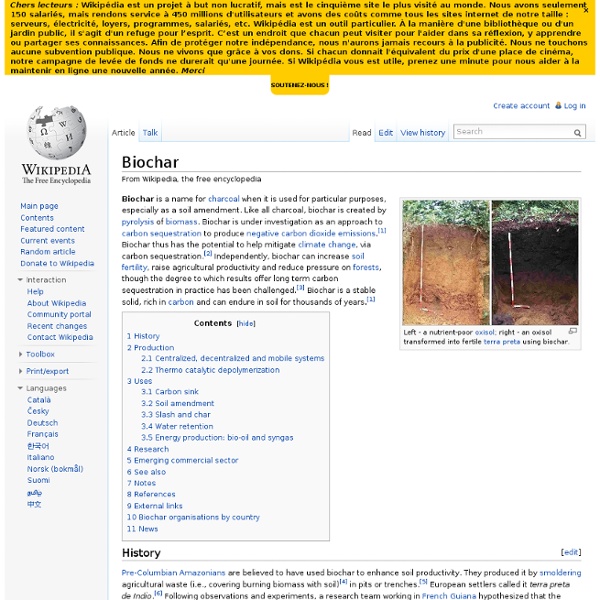International Biochar Initiative | International Biochar Initiative
Carbon sink: Kyoto protocol
Symphony of the Soil
Tree Disease identification, symptoms, treatment options for tree diseases
There are many different diseases that affect landscape trees and shrubs. Control of tree and shrub diseases cannot be properly accomplished until the disease pest is identified. Identification of tree and shrub diseases is crucial because, although most diseases can be controlled, there are some diseases that cannot be controlled. Disease control on landscape trees and shrubs can sometimes be accomplished by more than one method, depending on the particular disease that if infecting your landscape plants. Even if you are going to attempt to control a disease that is infecting your landscape trees or shrubs you should consider consulting a local arborist.
Biosequestration: Biochar
Carbon sink
This diagram of the fast carbon cycle shows the movement of carbon between land, atmosphere, and oceans in billions of tons of carbon per year. Yellow numbers are natural fluxes, red are human contributions in billions of tons of carbon per year. White numbers indicate stored carbon. A carbon sink is a natural or artificial reservoir that accumulates and stores some carbon-containing chemical compound for an indefinite period. The process by which carbon sinks remove carbon dioxide (CO2) from the atmosphere is known as carbon sequestration. Public awareness of the significance of CO2 sinks has grown since passage of the Kyoto Protocol, which promotes their use as a form of carbon offset. General[edit] The natural sinks are: Absorption of carbon dioxide by the oceans via physicochemical and biological processesPhotosynthesis by terrestrial plants Natural sinks are typically much bigger than artificial sinks. Carbon sources include: Kyoto Protocol[edit] Soils[edit] Oceans[edit] Forests[edit]
Tree Encyclopedia
Trees have three principle features that distinguish them from all other plants. First, they have a woody stem, roots and branches which do not die back in winter, but continue to grow year after year. From the moment of its germination, a tree remains visible; from the tallest Sequoia to the smallest garden fruit tree, this principle of growth remains constant. Trees live longer than any other organism on earth. Trees commonly live more than 1,000 years, and many grow considerably older. A bristlecone pine, Pinus longaeva, at Schulman Grove in California has been documented both by core drilling (a pencil-thin core is taken from the tree’s trunk, and the rings are counted) and by carbon-dating as being 4,700 years old. Pando (Latin for “I spread”), aka “the trembling giant,” is a clone colony of male quaking aspen, (Populus tremuloides) a single living organism identified by identical genetic markers. Family Aceraceae: Maples are some of our most familiar and beloved trees.
Managing soil carbon: Data available on Soil organic Carbon
Carbon sink: General
Regrarian Handbook
*1. CLIMATE CHAPTER’ eHANDBOOK (77 pages) available NOW for only AUD$5!! *ON SALE as a FULL HARDCOPY late-2015!! The ‘Regrarians Handbook’ is a succinct & sequential outline of over 300 integrated methodologies and techniques that have been proven over many years of universal application to work towards regenerating human & livestock’s lives along with production landscapes. Darren has joined forces with ‘Permaculture: A Designers’ Manual‘ (1988) Designer, Illustrator & Editor Andrew Jeeves in what promises to be the production of an ‘instant classic’. “…The layout by Andrew Jeeves is informative, attractive and simple; his drawings express concisely points sometimes belaboured in the text. Mark Hankins, Right by Design, New Scientist, December 1989 (of ‘Permaculture: A Designers Manual’) The size, feel & format of this book is that of a handbook such that it is an easy and ready accompaniment to the emerging Regrarians kit. The secondary inspiration was that of the late P.A.
Biochar's long-term benefits to soil proven | Rural Weekly
AFTER 10 years of intensive research, Southern Cross University and Department of Primary Industries scientists have for the first time quantified the long-term accumulation of carbon in soil following a single application of biochar. The research, recognised and published in the international Nature Climate Change Journal, was conducted on 36 plots at the Wollongbar Primary Industries Institute. Biochar derived from eucalypt residues was applied in 2006 into a pasture soil managed for intensive dairy production, with periodic cuts to simulate grazing. Some plots had biochar with the green waste, others with cow manure and some with and without lime. The lime - and the manure - increased the production of rye grass, which was sown, as on a normal dairy farm, every March/April. The project's leader, DPI researcher and SCU adjunct professor Lukas Van Zwieten said the research threw up some unexpected results.



